An upwards swing was expected but did not happen.
Summary: Silver is range bound with support about 16.05 – 15.70 and resistance about 18.55 – 18.65. It looks likely that a downwards breakout may be imminent for Silver.
New updates to this analysis are in bold.
Last monthly chart is here.
ELLIOTT WAVE COUNT
FIRST WEEKLY CHART
Cycle wave b may be completing as a double combination: zigzag – X – flat. The second structure, a flat correction for primary wave Y, may be underway.
Within a flat correction, intermediate wave (B) must retrace a minimum 0.9 length of intermediate wave (A) at 15.938. The common range for intermediate wave (B) is from 1 to 1.38 the length of intermediate wave (A). The target calculated would see intermediate wave (B) reach to within the common range and pass its minimum requirement. If minor wave B moves any higher, then the target for intermediate wave (B) must also move correspondingly higher.
Intermediate wave (B) may make a new price extreme beyond the start of intermediate wave (A), as in an expanded flat, which are very common structures.
The bigger picture for cycle wave b would expect primary wave Y to end about the same level as primary wave W about 21.062. The purpose of combinations is to take up time and move price sideways. To achieve this purpose the second structure in the double normally ends about the same level as the first.
The maximum number of corrective structures is three within combinations (and multiple zigzags). This maximum applies to sub-waves W, Y and Z. Within these structures, they may only be labelled as simple A-B-C corrections (or A-B-C-D-E in the case of triangles). They may not themselves be labeled multiples as that would increase the number of corrections within the structure beyond three and violate the rule.
X waves are joining structures and they are not counted in the maximum total of three (otherwise the maximum would be five). X waves may be any corrective structure, including multiples.
While the combination wave count at the weekly chart level does not currently work for Gold, it does still work for Silver. They do not have to complete the same structures for cycle wave b, and fairly often their structures are different.
FIRST DAILY CHART
Minute wave ii was over the day after last analysis was published.
Minor wave C must complete as a five wave motive structure, either an impulse (more likely) or an ending diagonal (less likely but possible). Let us assume the most likely structure unless proven otherwise.
Minute wave iii is labelled as almost complete, with only minuette (v) to go. But the labelling within it may also be moved down one degree, so only minuette wave (i) may be completing. If this is so, then minuette wave (ii) may not move beyond the start of minuette wave (i) above 16.897.
Downwards movement for Wednesday’s session has bounced up strongly from the lower edge of the base channel. If price moves higher here from support, then it should find strong resistance at the upper edge of the base channel. That upper line should not be breached while minute wave iii is underway.
When it arrives, then minute wave iv may not move back up into minute wave i price territory above 16.368.
SECOND WEEKLY CHART
It is also possible that cycle wave b may be completing as a triangle. Mostly because combinations are more common than triangles is this a second wave count.
Within a triangle, only one of the sub-waves may be a more complicated multiple. Primary wave B subdivides as a double zigzag. Primary waves C, D and E may only be single threes.
Within a contracting or barrier triangle, primary wave C may not move beyond the end of primary wave A above 21.062.
Recent price movement has made the triangle as labelled in last analysis now look wrong. It may be that primary wave C was over at 18.641. If it was, then it looks like a clear three wave structure that is shallower than triangle sub-waves usually are.
Primary wave D may now be underway.
Within a contracting triangle, primary wave D (nor any part of primary wave C) may not move beyond the end of primary wave B below 15.638.
Within a barrier triangle, primary wave D should end about the same point as primary wave B. As long as the B-D trend line remains essentially flat the triangle will remain valid. In practice, this means that primary wave D may move slightly below the end of primary wave B (this is the only Elliott wave rule which is not black and white).
The final wave of primary wave E may not move beyond the end of primary wave C. It would most likely fall short of the A-C trend line.
This second wave count expects a large consolidation to continue for months.
SECOND DAILY CHART
The problem now becomes the structure within primary wave D. It must complete as a zigzag, and intermediate wave (C) within it must complete as an impulse.
Within intermediate wave (C), it looks like only minor waves 1 and 2 are recently over. Minor wave 3 should be underway.
It looks like there may not be enough room for the whole structure of minor wave C to complete and price to remain at or above 15.638. This wave count is possible, but does not look very likely.
TECHNICAL ANALYSIS
WEEKLY CHART
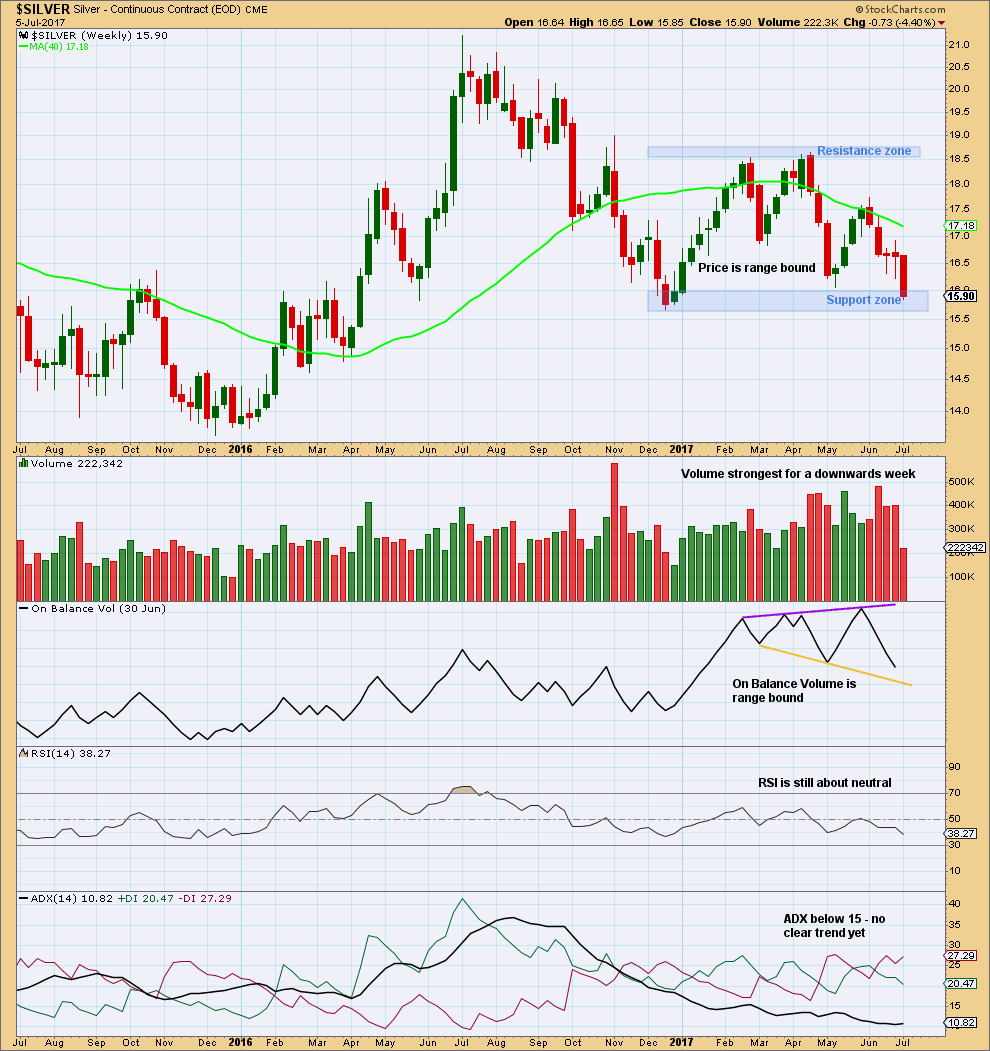
Click chart to enlarge. Chart courtesy of StockCharts.com.
Volume now suggests a downwards breakout from the trading range is more likely than upwards.
Overall, Silver is in a large consolidation at the weekly chart level. Support is about 16.05 – 15.70 and resistance is about 18.55 – 18.65. ADX agrees that price is consolidating.
Price is now again at support. How it behaves here will indicate what should happen next. If price can break below support, then look for a retest of resistance there and a move down and away. If price bounces up here from support, then look for an upwards swing back up the the resistance zone.
DAILY CHART
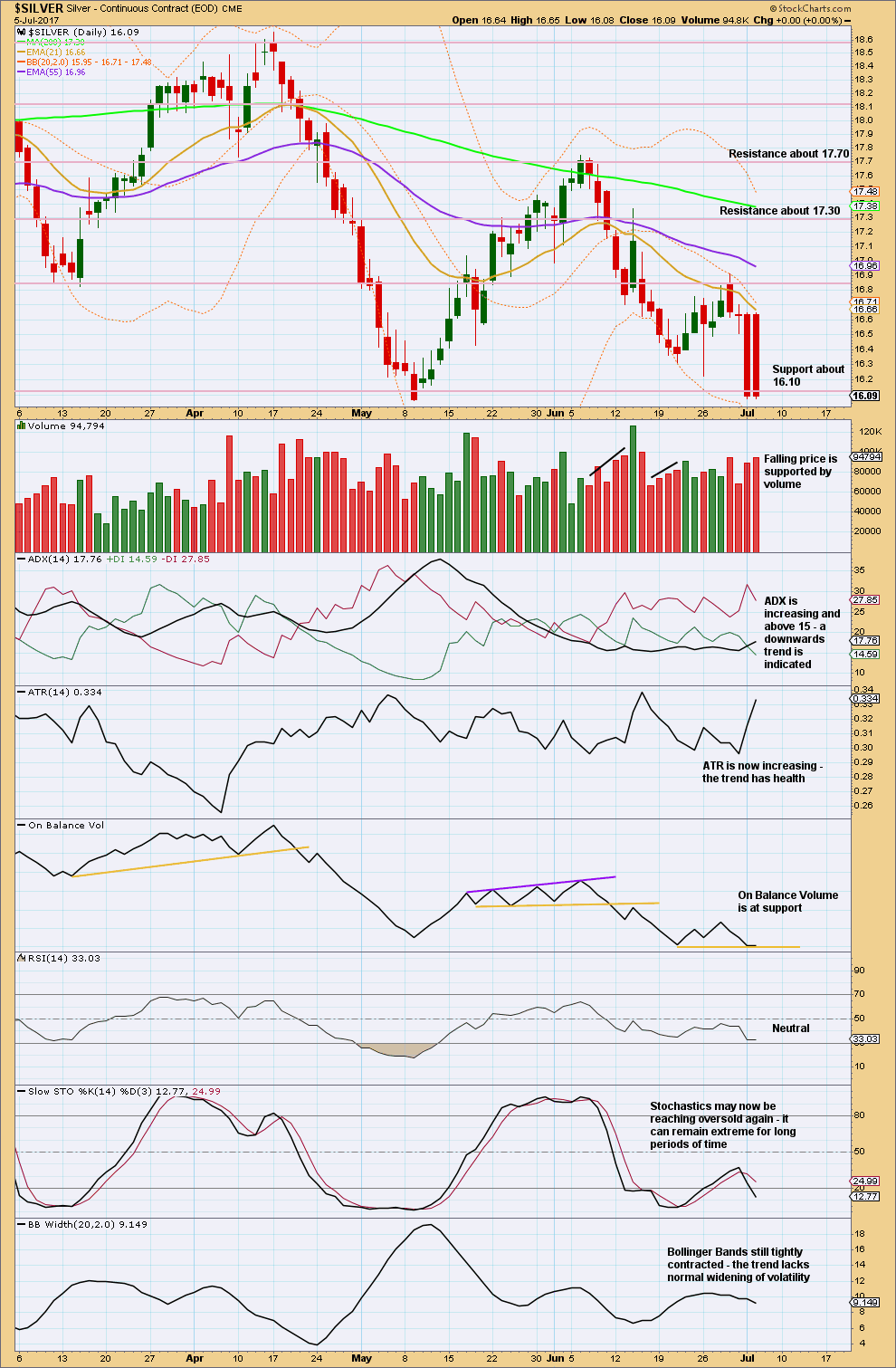
Click chart to enlarge. Chart courtesy of StockCharts.com.
StockCharts have the same problem with their data for Silver as they do for Gold.
Volume is bearish. ATR is bearish. ADX is bearish.
Bollinger Bands are not widening yet with this trend. They may yet do so, or this may be a warning that the trend is not normal and may be short lived.
A break below support for On Balance Volume would be only a very weak bearish signal. This trend line is new.
This analysis is published @ 09:43 p.m. EST.

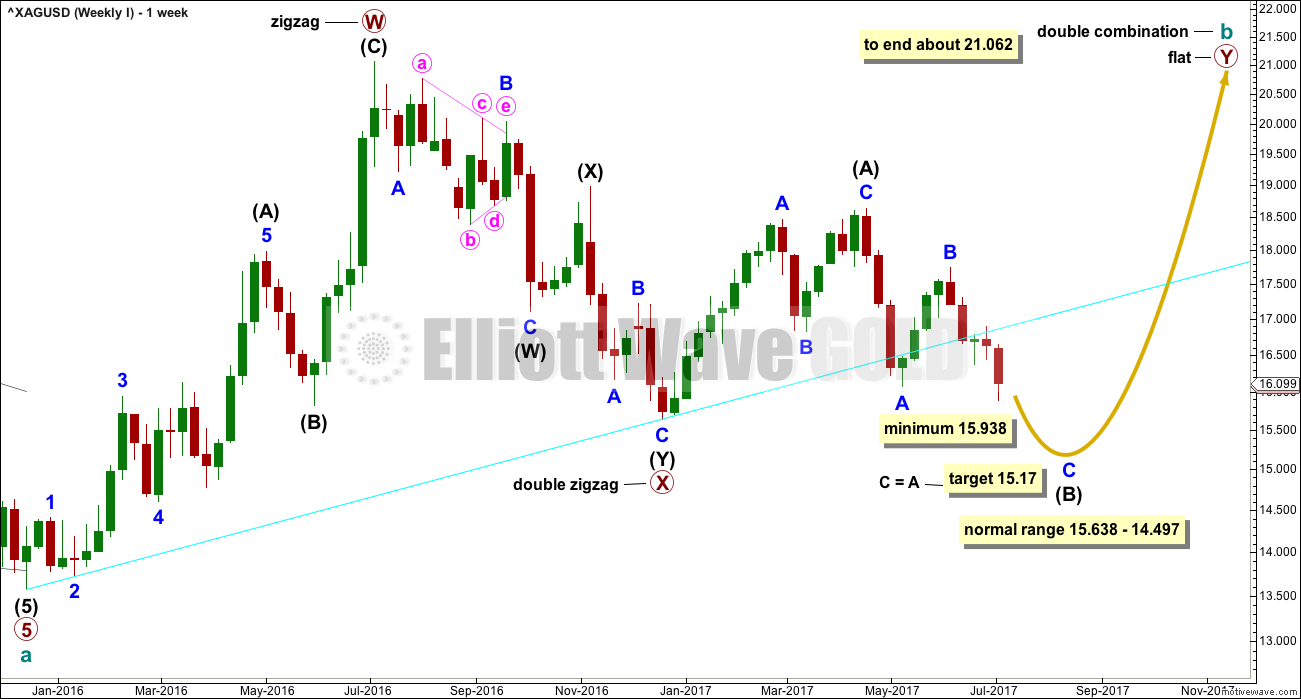
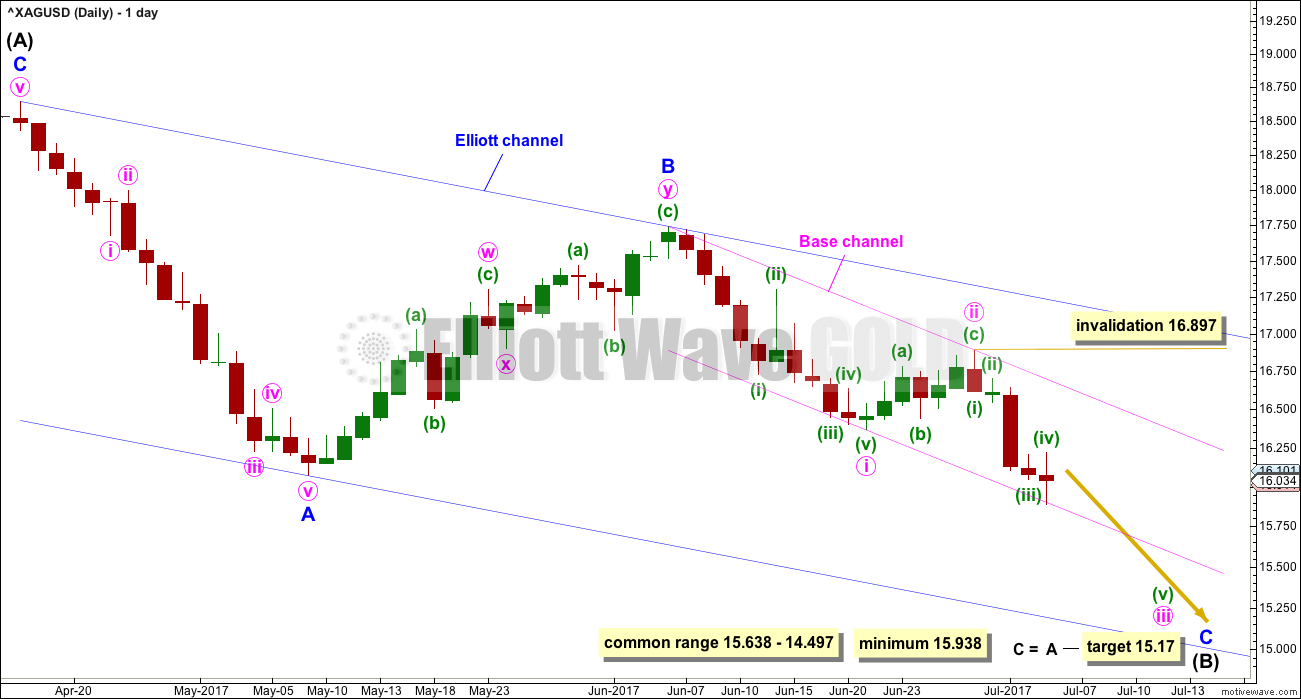
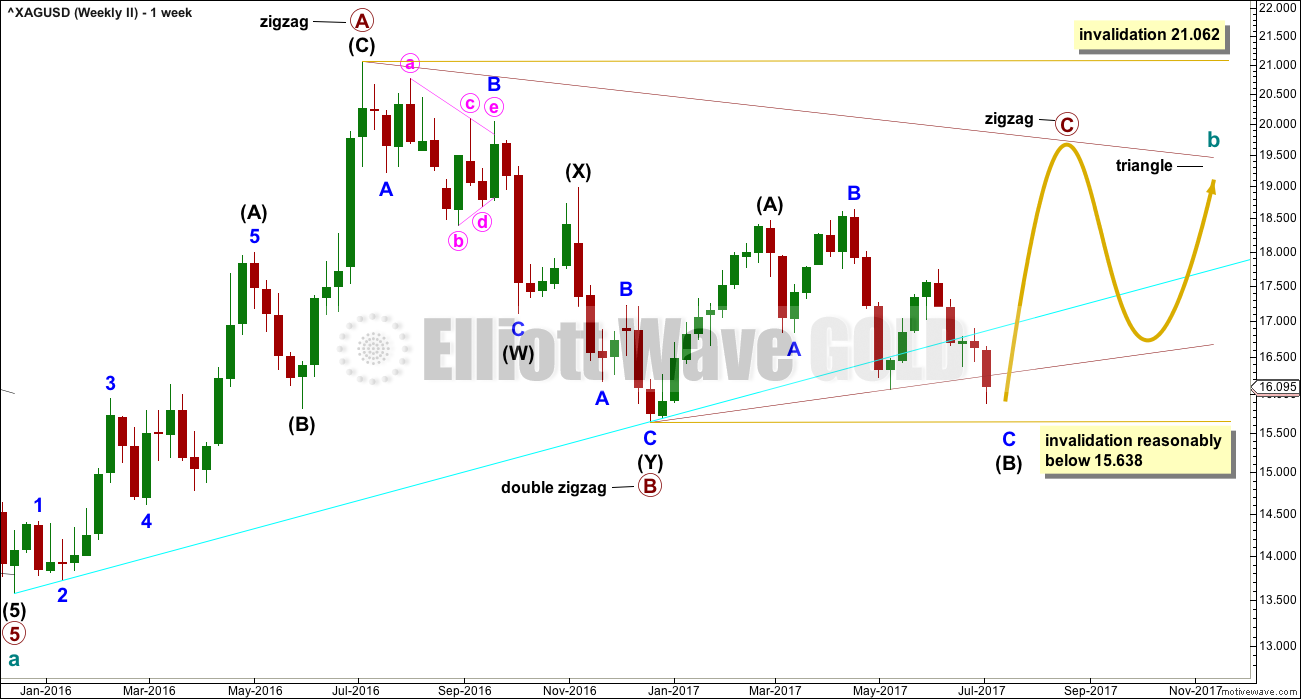
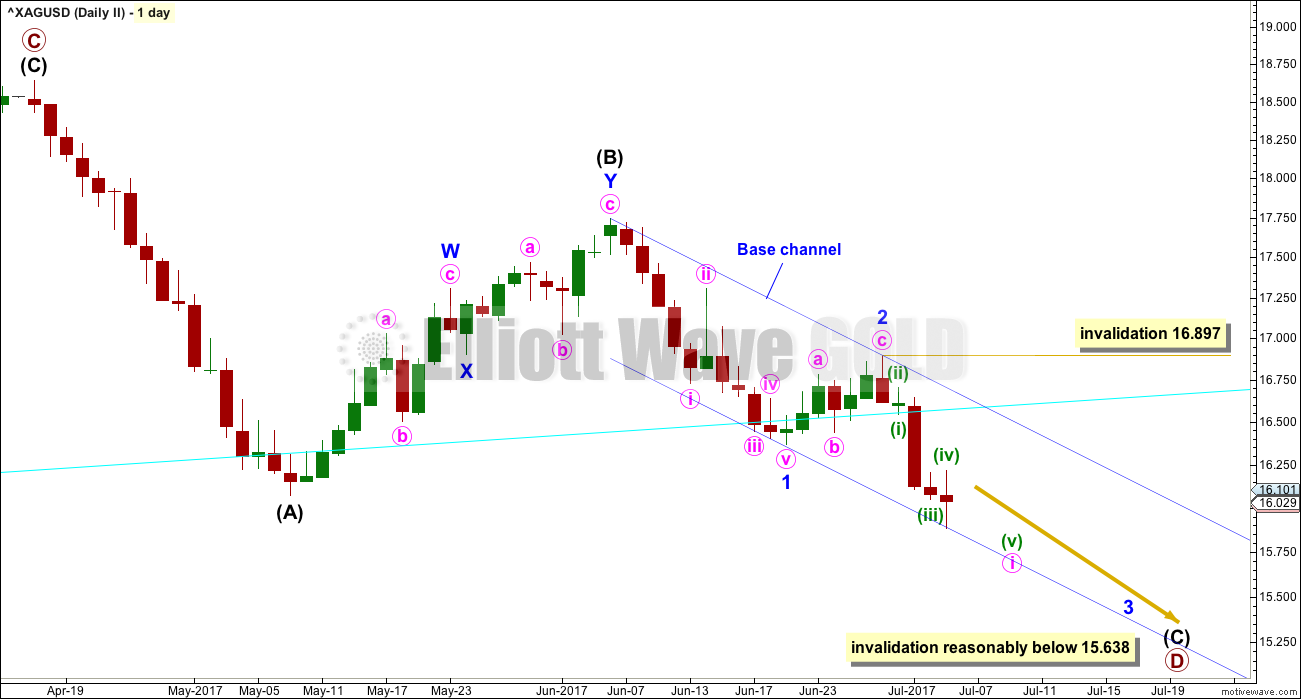
Any update since the 7/7 drop in silver hit the mid $14 range and rebounded for the close would be appreciated. Think C of (B) is complete? Thanks